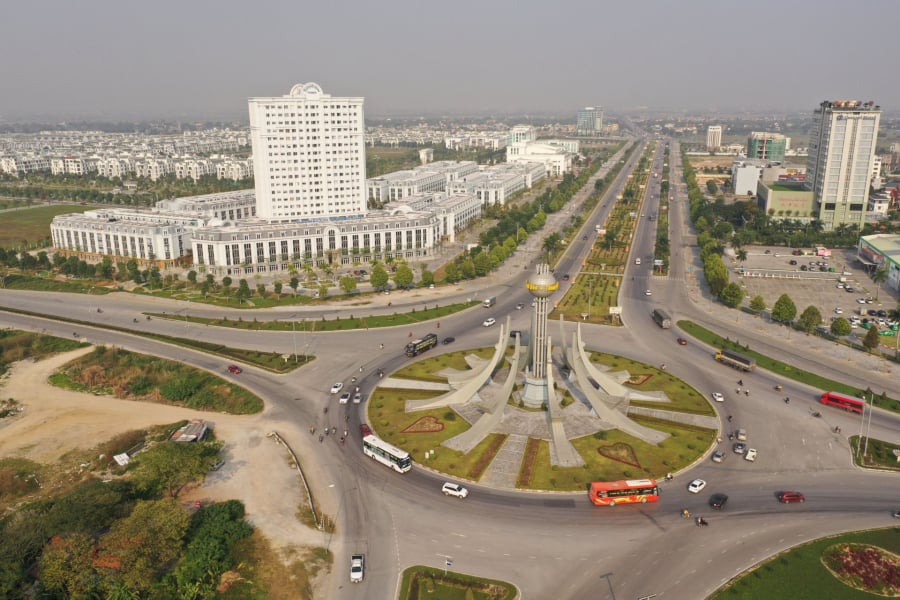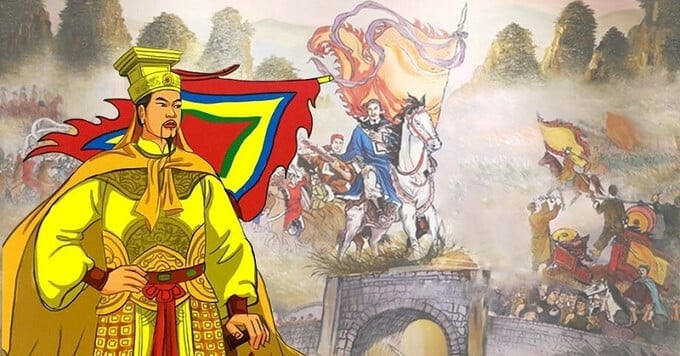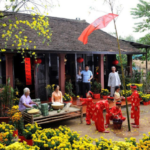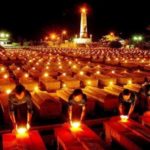There is an ancient saying that goes: “The king of Thanh, the god of Nghệ” because Thanh Hóa is the land of “unified imperial meetings,” and the majority of kings and lords have originated from here.
Thanh Hóa is the only place known as the “land of kings”
According to historical records, Thanh Hóa is indeed the “cradle” of many kings and lords in Vietnam with four royal dynasties, including the Early Lê Dynasty (3 persons), the Hồ Dynasty (2 persons), the Later Lê Dynasty (26 persons), and the Nguyễn Dynasty (13 persons); besides, there are also two lineages, Trịnh and Nguyễn.
This sacred and extraordinary land is considered the most sacred in Vietnam. Many believe that this region contains dragon veins and converges spiritual energy, which is why it has produced so many kings and lords. Even now, there is still no specific answer as to why Thanh Hóa has given birth to so many emperors, heroes, and talents.

According to feng shui and geography, Thanh Hóa has a strategic position like a separate kingdom, advantageous with both forests and seas, as well as rivers and old-growth forests. Because it is a sacred land, Trần Thiếu Đế from the Trần Dynasty, had to order the digging of mountains and filling of rivers here to stabilize the emperor’s dragon veins.
This is confirmed by the unofficial Vietnamese history book, the Việt sử địa dư, by Phan Đình Phùng, which says: “In the 17th year of Emperor Trần Thái Tông’s Thiên Ứng Chính Bình reign (1248), a feng shui expert was sent to suppress the auspicious energy in all the mountains and rivers, such as Chiêu Bạc Mountain, Bà River, Lễ River in Thanh Hóa, and dug them up. Filled the riverbeds, opened horizontal and vertical roads without counting.” But this effort was like salt in the sea, as right after the Trần Dynasty, the Hồ Dynasty, the Later Lê Dynasty, and the Nguyễn Dynasty all emerged from Thanh Hóa. In addition to that, there are countless legends associated with Thanh Hóa in the process of establishing dynasties. This land is still considered the “land of kings and lords” unmatched in our country.
The hometown of 4 royal dynasties and 2 lineage lords of Vietnam
+ Lệ Hải Bà Vương (Madam Triệu) – Triệu Thị Trinh
The first milestone was in the Mậu Thìn year (248) when Madam Triệu defeated the Ngô army at Nưa Mountain, Triệu Sơn, Thanh Hóa, making the enemy soldiers surrender with the proverbial saying “Performing dances with spears fighting tigers/ Facing Madam the King is difficult” (Giaocard fighting tigers is easy/ Facing Queen Madam is difficult). Although she did not establish a dynasty, the Ngô army already honored her as their queen.
+ Giao Châu Tiết Độ Sứ (Governor of Giao Châu) – Dương Đình Nghệ
In December of the Tân Mão year (931), Dương Đình Nghệ, born in Giàng Village, now belonging to Thiệu Dương Commune, Thiệu Hóa District, Thanh Hóa Province, expelled the Lý Khắc Chính and Lý Tiến envoys from the Đường Dynasty, occupied Đại La City, and proclaimed himself as the Governor of Giao Châu, but in fact, he was an “unofficial king” since he continued the independent and autonomous regime established by the Khúc Clan since Ất Sửu (905).
+ Đại Hành Hoàng Đế (Emperor Đại Hành) – Lê Hoàn
In the 7th month of the Canh Thìn year (980), Queen Dương Vân Nga invited the Ten Heroes General Lê Hoàn to ascend the throne to unify the people’s hearts in resisting the invading Tống Dynasty, thereby establishing the Early Lê Dynasty (980-1009). Lê Hoàn, also known as Emperor Lê Đại Hành, originally came from Xuân Lập Commune, Thọ Xuân District, Thanh Hóa Province. The Early Lê Dynasty spanned three generations, including Emperor Lê Đại Hành (980-1005), Emperor Lê Trung Tông (1005), and Emperor Lê Ngọa Triều (1005-1009).
+ Hồ Quý Ly
Over 500 years later, also in the Canh Thìn year (1400), Hồ Quý Ly, the outside heir, usurped the Trần Dynasty and established the Hồ Dynasty with the country named Đại Ngu and the capital in Tây Giai City, which is present-day Thanh Hóa. His ancestors originally came from Jiāngzhe, China, but later migrated to Diễn Châu, Nghệ An, and settled in Đại Lại, Thanh Hóa. The Hồ Dynasty lasted two generations within 7 years (1400-1407).
+ Thái Tổ Hoàng Đế (Emperor Thái Tổ) – Lê Lợi
The period from 1428 to 1789 is the period of the Hậu Lê Dynasty, including the Early Lê (1428-1527) and Lê Trung hưng (1533-1789) stages. The founding figure of the Hậu Lê Dynasty was Lê Thái Tổ (Lê Lợi), after the victory of the Lam Sơn uprising against the Ming invaders (1416-1428). He was born in Xuân Lam Commune, Thọ Xuân District, Thanh Hóa Province. The Early Lê period went through 10 kings from Emperor Lê Thái Tổ to Emperor Lê Cung Hoàng, considered the golden age of the Đại Việt feudal regime, reaching its peak with Emperor Lê Thánh Tông’s reign (1460-1497). The Lê Trung hưng period marked the recovery of the Lê Dynasty after being overthrown by Mạc Đăng Dung, with the first king being Emperor Lê Trang Tông (1533-1548), and ending with the 16th king, Emperor Lê Chiêu Thống (1786-1789).

+ Nguyễn Dynasty
The last dynasty of Vietnam was the Nguyễn Dynasty (1802-1945) founded by Nguyễn Ánh Gia Long. His ancestors were originally from Gia Miêu, an exonym belonging to Tống Sơn District (Hà Long Commune, Hà Trung District nowadays), Thanh Hóa. The Nguyễn Dynasty had 13 kings, starting with Emperor Gia Long (1802-1820) and ending with Emperor Bảo Đại (1926-1945). In the history of the southern part of our country, it is officially recorded that there were two lineages, the Trịnh Lords and the Nguyễn Lords. Both lineages originated from Thanh Hóa.
+ Minh Khang Thái Vương (Prince Minh Khang) – Trịnh Kiểm
The Trịnh Lords of the Lê Dynasty from the 16th to the 18th centuries were established by Trịnh Kiểm. He originally came from the poor village of Sóc Sơn, Vĩnh Lộc District, Thanh Hóa. Although they were known as the assistants to the Lê Dynasty, the actual power of the Trịnh Lords overshadowed the Lê Dynasty, with a court if the king had a palace, the Trịnh Lords had a governmental office. During the Late Lê period, Lê Dynasty only had a nominal role. The Trịnh lineage started with Trịnh Kiểm (1545-1570) until the time of Trịnh Bồng (1786-1787), spanning 11 generations before finally being wiped out by Nguyễn Huệ, the King of Bắc Bình.
+ Tiên Chúa – Nguyễn Hoàng
Regarding the Nguyễn Lords, in the Mậu Ngọ year (1558), Nguyễn Hoàng listened to advice from the famous scholar Nguyễn Bỉnh Khiêm, who said, “Crossing the mountain, you can contain your body,” and came to govern Thuận Hóa. Lord Tiên Nguyễn Hoàng was the second son of An Thành Marquis Nguyễn Kim, born in Gia Miêu. The Nguyễn lineage went through 9 generations from Nguyễn Hoàng (1558-1613) to Nguyễn Phúc Thuần (1765-1777), who saw the founding and expansion of the land of Đàng Trong (Southern Land) until Mũi Đất, Cà Mau…
Thanh Hóa is the intersection between the Northern Delta and the Northern Central Region and can be seen as the “bridal gown” of the southern region to the northern realm. Thanks to its natural geography with Tam Điệp and Biện Sơn providing protection, and the Mã River, Lương River, and Ngọc Giáp River converging within, this region possesses a rare military advantage. With such a strategic position, it shaped the strong-willed, resourceful, and revolutionary character of the people here. It is from this natural and human balance that the Ai Châu region has become a favorable place for proclaiming kings and establishing nations. Therefore, to say that Thanh Hóa is a land of spiritual richness and human talent from ancient times to the present is not an exaggeration.
Explore 12 Amazing Destinations for Biking Trips
Unlock Vietnam in a brand new way with an exciting biking tour! Discover the stunning beauty of the country with Dien May XANH’s top 12 must-see destinations. From sweeping plains to clear blue beaches and mountainous vistas – experience all the sights with your own personal cycling tour. Find your ideal route and set out for an adventure today!




































